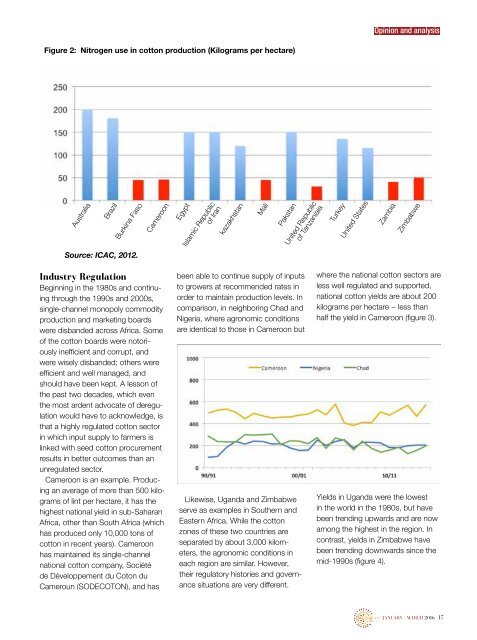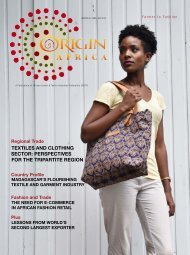You also want an ePaper? Increase the reach of your titles
YUMPU automatically turns print PDFs into web optimized ePapers that Google loves.
Opinion and analysis<br />
Figure 2: Nitrogen use in cotton production (Kilograms per hectare)<br />
Australia<br />
Brazil<br />
Burkina Faso<br />
Source: ICAC, 2012.<br />
Cameroon<br />
Egypt<br />
Islamic Republic<br />
of Iran<br />
kazakhstan<br />
Mali<br />
Pakstan<br />
United Republic<br />
of Tanzaniaia<br />
Turkey<br />
United States<br />
Zambia<br />
Zimbabwe<br />
Industry Regulation<br />
Beginning in the 1980s and continuing<br />
through the 1990s and 2000s,<br />
single-channel monopoly commodity<br />
production and marketing boards<br />
were disbanded across <strong>Africa</strong>. Some<br />
of the cotton boards were notoriously<br />
inefficient and corrupt, and<br />
were wisely disbanded; others were<br />
efficient and well managed, and<br />
should have been kept. A lesson of<br />
the past two decades, which even<br />
the most ardent advocate of deregulation<br />
would have to acknowledge, is<br />
that a highly regulated cotton sector<br />
in which input supply to farmers is<br />
linked with seed cotton procurement<br />
results in better outcomes than an<br />
unregulated sector.<br />
Cameroon is an example. Producing<br />
an average of more than 500 kilograms<br />
of lint per hectare, it has the<br />
highest national yield in sub-Saharan<br />
<strong>Africa</strong>, other than South <strong>Africa</strong> (which<br />
has produced only 10,000 tons of<br />
cotton in recent years). Cameroon<br />
has maintained its single-channel<br />
national cotton company, Société<br />
de Développement du Coton du<br />
Cameroun (SODECOTON), and has<br />
been able to continue supply of inputs<br />
to growers at recommended rates in<br />
order to maintain production levels. In<br />
comparison, in neighboring Chad and<br />
Nigeria, where agronomic conditions<br />
are identical to those in Cameroon but<br />
Likewise, Uganda and Zimbabwe<br />
serve as examples in Southern and<br />
Eastern <strong>Africa</strong>. While the cotton<br />
zones of these two countries are<br />
separated by about 3,000 kilometers,<br />
the agronomic conditions in<br />
each region are similar. However,<br />
their regulatory histories and governance<br />
situations are very different.<br />
where the national cotton sectors are<br />
less well regulated and supported,<br />
national cotton yields are about 200<br />
kilograms per hectare − less than<br />
half the yield in Cameroon (figure 3).<br />
Yields in Uganda were the lowest<br />
in the world in the 1980s, but have<br />
been trending upwards and are now<br />
among the highest in the region. In<br />
contrast, yields in Zimbabwe have<br />
been trending downwards since the<br />
mid-1990s (figure 4).<br />
JANUARY - MARCH 2016 17



